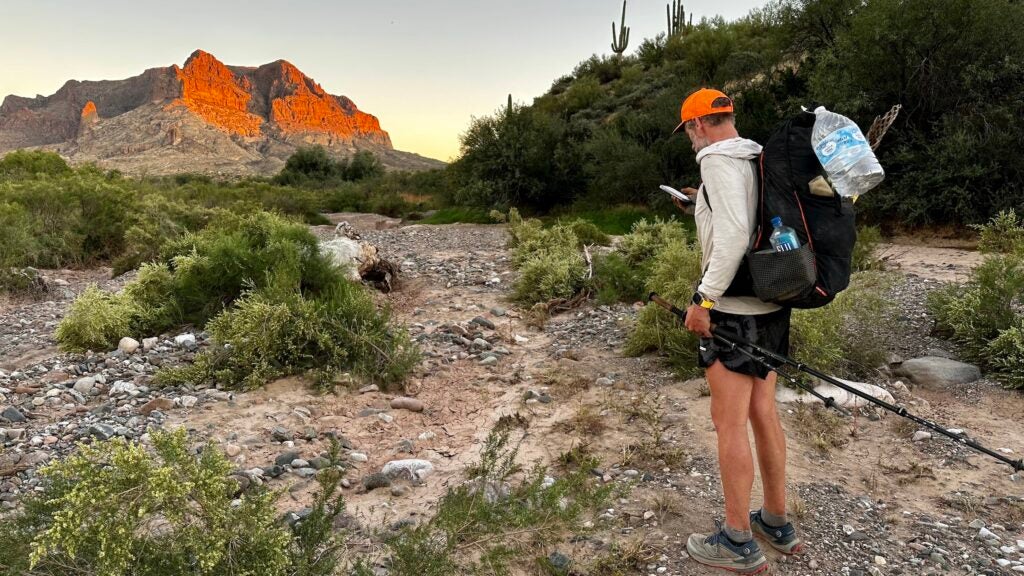No products in the cart.
Outdoor Adventure
If You Don’t Have Time for a Long Thru-Hike, the Arizona Trail Is a Perfect—and Spectacular—Shorter Trek
The most commonplace question about long-distance hiking is also the most complicated to answer: How do you find the resources—the time, the money, the petcare, the childcare—to walk into the woods and away from the rest of your life for four months or more?
Put simply, after more than 7,000 miles and more than a cumulative year spent sleeping on trail since 2019, it has required rearranging everything, from work schedules and career ambitions to the decision to live in a van when my wife, Tina, and I aren’t in a tent. But I know that’s a privilege of circumstance and commitment, not at all possible for most people, especially in our withering economic circumstances. Five days is a hopeful vacation. Five months? That’s a fantasy.
But is six weeks—a sabbatical or close to it—more viable? Can you set aside your responsibilities to hike for that long? If so, here is my zealous endorsement of the Arizona Trail, not the shortest or longest or most famous of the United States’ many national scenic trails, but the one that packs the most variety into less than 800 miles. As I write this, I sit 160 miles from its southern endpoint at the Arizona-Mexico border, but I’ve already started to imagine when I might return to this narrow strip of charmed land and perhaps bring a newcomer with me. I’ve got ten reasons I think you should consider it for your own debut, too, and five tips to help you along the way.
First, some caveats: This trail is difficult, and it will force you to search for water in a completely new way, sometimes toting it from pungent cow ponds for 20 miles at a clip. You will fall and cut yourself and curse, too, but that’s a thru-hike. And Tina dislikes this trail—actually, hate is only barely too strong a word—for many of the very reasons with which I champion it below. Hey, hike your own hike, you know?
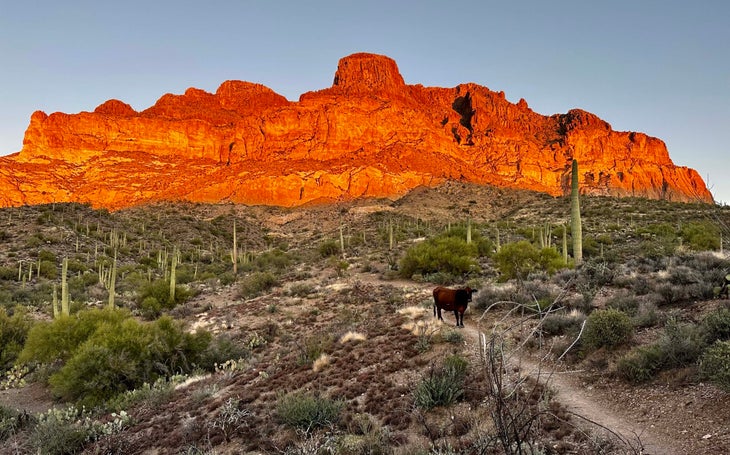
1. See the Grand Canyon Right
Let’s be pessimistic and imagine this experiment fails, that after 100 miles you realize with a grimace and, say, some shin splints that thru-hiking just isn’t for you. In that case, congratulations: you have successfully walked from the Utah border through the Grand Canyon, making the rim-to-rim pilgrimage that forever remains on the bucket list of millions. About 80 gorgeous miles beyond the start, the trail hits the North Rim and begins its plummet of 6,000 vertical feet and two billion years of geologic accumulation to the beleaguered Colorado River, now a slowed flow of cheap chocolate milk.
No matter how many times I’ve been inside the labyrinth (this was my fourth visit), this trek remains uncannily spectacular, unfolding before me like some puzzle I can see in all its vivid colors but never truly grasp. Nearly as soon as you reach the busy South Rim, you’ll hit the century mark. If it’s necessary (and I hope it won’t be), finding your emergency exit to Flagstaff or beyond won’t be hard. Also, manage your miles so you spend one night in the Bright Angel campground, feet away from the Colorado River and beneath stars so crisp you might try to touch them. (You can get a permit at the Backcountry Information Center the day of arrival.) Sure, you can make it out of the canyon in a day, but do you rush dessert at a Michelin-star restaurant?
2. Bask in Variety
When I told people I’d be hiking across Arizona, many assumed it was a month-long play in but two acts: the Grand Canyon and the vast, unspeakable, seemingly half-alive desert, stretching repetitiously to the vanishing point. But my favorite part of the Arizona Trail is the variety that unfolds within the state’s borders, from ponderosa forests so thick and luxe you feel like you’re bathing in their musk of vanilla bark and piquant needles to rocks so deeply red you seem to be living inside an ochre blossom. The trail near the murky Gila River radiates wildness and a hint of danger, while the land above Tucson at Mount Lemmon is as verdant and lush as the Sierra Nevada.
Bits of the Arizona Trail remind me of the best moments of every other long trail I’ve hiked, like the way the open expanse of the Kaibab Plateau sometimes summons those mysterious Appalachian balds or mesa tops recall the piney woods of Florida. Where the Mogollon Rim marks the edge of the vast Colorado Plateau 300 miles in, ponderosa and cacti and red rock and mountainous spires commingle in an unexpected collision, a nexus of the state’s multitudes. Stop and stare a while.
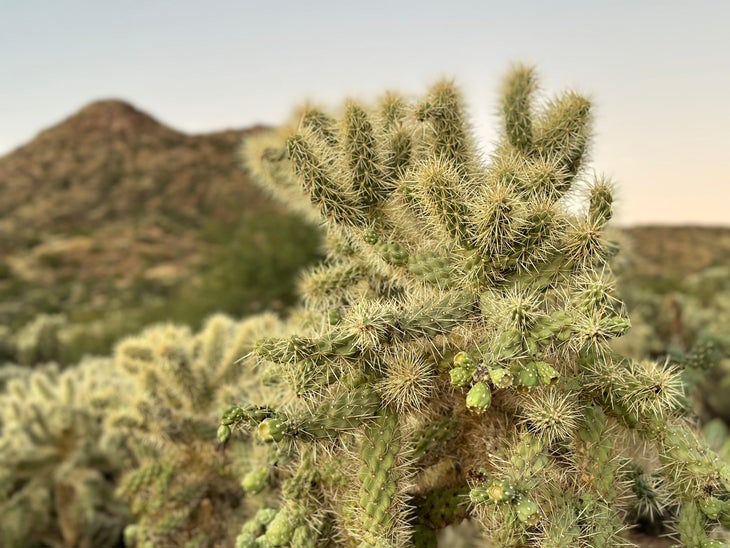
3. Respect the Pacing
Have you ever listened to a piece of music and noticed the way a chord changes or an unanticipated texture joins at the right moment, just as your mind begins to stray? Or took note of the way an experienced film director cuts away from a scene just in time to tantalize you? That’s how the Arizona Trail works for me, meting out its wonder in phases so well-timed they seem practiced and deliberate.
Just when you’ve fluttered like a butterfly through miles of quaking aspens, you drop into the Grand Canyon. Just when you’ve cruised through massive stands of towering pines, you drop off the Mogollon Rim and climb through the rugged and sweeping Mazatzal Mountains. Just when you’ve clambered over all those peaks, the Sonoran Desert opens up before you, seemingly ceaseless and still. Such pacing is a trick of changing elevations and latitudes, and the Arizona Trail plays it perfectly.
4. Embrace the Unpredictability
Especially on the Appalachian Trail, hikers frequently lament PUDS—that is, pointless ups and downs, or sections of trail that seem to go up, down, and up again with no apparent purpose except the titillation of Trail Boss Marquis de Sade. The Arizona Trail indulges this, too, sending you into the shadows of canyons you could have easily avoided or in and out desert washes you could have skirted so many times you will inevitably suffer déjà vu. This sometimes drives me bonkers, and I’ve muttered “Oh, fuck you” to the imagined trail crew more than once. But as with the big-picture pacing, that uncertainty—going up when I swear I should be going down, heading east just to jut back south, zigging when I’m pretty sure I should be zagging—keeps me guessing and engaged. As majestic as it can be, the Pacific Crest Trail is prosaic and predictable on this granular level, its terms abiding and consistent; the Arizona Trail is a gnarly and gnarled rebuff, a madcap diorama of chutes when you expect ladders.
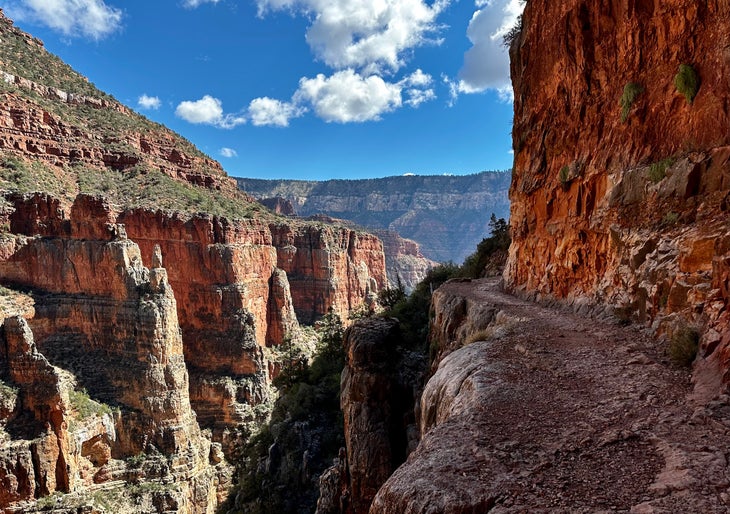
5. See the Signs
I like to walk, a lot, but I also like to know about where I’m walking, about the ecology, geology, and human history of the spaces I’m wandering on foot. Otherwise, why not just strap on a VR headset or walk 800 miles on one of those treadmills with the big screens? More than most, the Arizona Trail tells you about where you are, with trailhead signs indicating which Native American tribes have called this zone home or which flora and fauna you might spot. You’ll pass old timber railroad lines and cattle ranches rich with information about the past, and even a charming interpretive trail about the dangers of “dwarf mistletoe.”
There could always be more, of course, like when you near the site of an 1871 Indigenous massacre at Camp Grant, but at least the Arizona Trail is striving to tell you about where you are, to give your brain some exercise, too. Most long trails barely try, a missed opportunity for education. And maybe this seems like a trivial thing, but the armada of trail gates and signs—all made from massive pieces of oxidized steel, like some Richard Serra understudy gave up on sculpture and fell in love with wayfinding—are gorgeous, a welcome aesthetic addition to a trail consistent only in beauty.
6. Be Social—Or, Not
If vows of silence are your thing, it’s possible—perhaps even easy?—to walk the length of Arizona only nodding at occasional other hikers. It is quickly growing in popularity, with the index of finishers rapidly mounting; according to Matthew Nelson, the executive director of the Arizona Trail Association, the number of annual thru-hikers has increased tenfold in a decade. Still, officially completed only in 2011, it’s not even a teenager within the country’s trail system, so new that many Arizonians barely know it exists.
But there are enough hikers here to form a trail family if that’s an experience you crave, and I’ve found that the hiking résumés are especially varied. I’ve walked-and-talked with folks who have hiked 20,000 miles and seem to exist in perpetual motion and others for whom the Arizona Trail is a debut, a novel experiment in wherewithal. It’s also becoming a shoulder-season option for those that want a warm-up or cool-down before or after something like the AT or PCT, so you can ask all about their experiences on these landmark routes should you want to keep going. You’ll also likely intersect with mountain bikers racing the trail, as they do every year, sporting their own brand of endurance craziness. On the banks of the Gila River on a hot day, I met a sardonic British biker in last place who had sworn off more races after getting badly lost the night before; when I miss a switchback, which is daily, I think of him and chuckle.
7. Surprise Your Friends
You don’t need to be a hiker at all to have a conception of the country’s major trails, just a moviegoer—Reese Witherspoon showed the world the PCT, Robert Redford the AT. But, wait…there’s a trail that cuts diagonally across Arizona, for 800 miles, from Utah to Mexico? That’s even a common reaction here when I tell people why I’m stumbling into their tiny town’s grocery store with a sweaty backpack and cactus-lacerated legs. Those big trails can sometimes feel overly planned, with stops in towns that depend on hikers for their economy; it’s as familiar and comfortable as a gas station along an interstate. It is good to be an outlier in Arizona, to be part of a scene that’s still establishing the normalcy of stuffing dehydrated mashed potatoes into your pack and walking down the streets of Pine while eating a pint of ice cream with a camp spork.
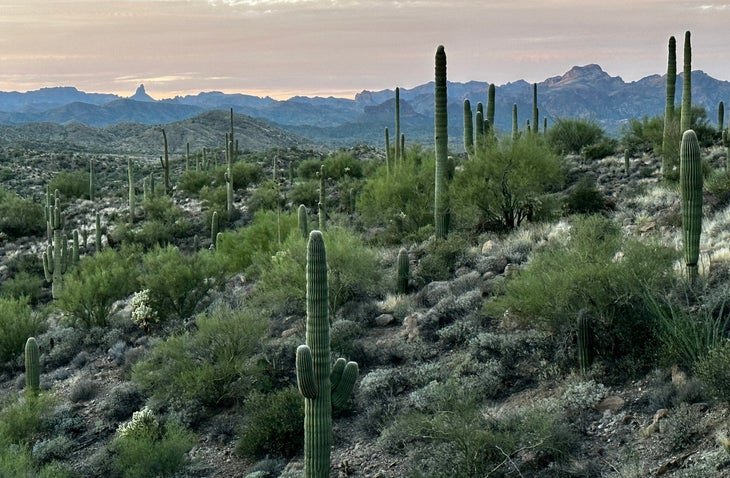
8. Be Captivated by Flora and Fauna
Pardon my East Coast ignorance, but until about two weeks ago, I didn’t know the coati existed. If you’re with me, the curious and quick critter looks like a racoon crossed with an anteater, but with the cuddly face of a baby bear and the body of a small dog. As I watched it scurry up tree after tree along a series of granite seeps, I felt as if I’d discovered a new species. The Jerusalem cricket, the greater short-horned lizard, the Grand Canyon black tarantula, the tarantula hawk: I’ve encountered them all in the last few weeks and been invariably stunned by how different they all are from the animals I know back home. Yes, there are big predators here, from mountain lions to a litany of rattlesnakes, but they have been fleetingly rare this fall. Instead, the idiosyncratic results of evolution abound, from towering ocotillos to tireless ant colonies, making their lives in a harsh climate in their singular and fascinating ways. It, like the trail itself, has offered surprise and delight.
9. Get Lost in the Color Show
I was prepared for fortresses of red rock and impressionistic seas of interweaving green and brown, the colors respectively associated with southern and northern Arizona. But I don’t know that I expected the shimmer of the fragile yellow leaves of quaking aspen copses above the Grand Canyon’s North Rim (alone, a reason to hike this trail in the fall rather than spring) or the rush of red, purple, and yellow wildflowers in the desert hundreds of miles to the south. And then there are the colors of the horizon, broadening like the spectrum of a fire by morning and fading into a lysergic wash by night. When the sun is gone, the nocturnal Arizona sky is one of the country’s best, even when you’re close to major cities like Phoenix or Tucson. Only occasional clouds crowd out the Milky Way or the full moon’s light, nearly inescapable in the desert. Try to spend your nights cowboy camping, and you won’t miss television for a minute.
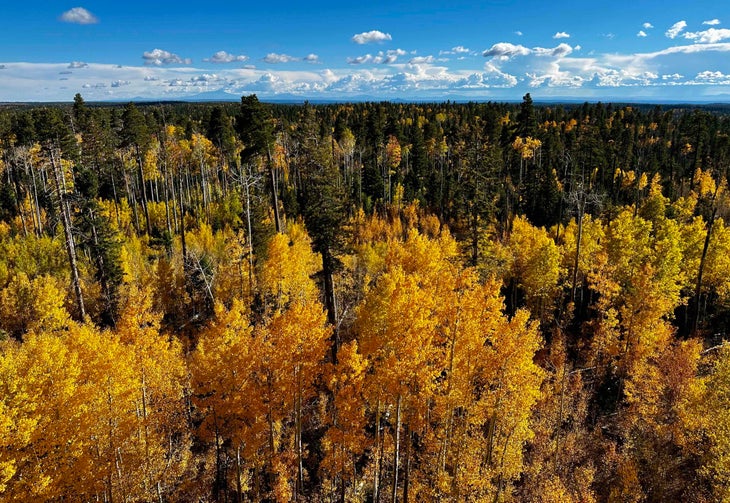
10. Go to Tucson
For more than 600 miles now, you’ve subsisted on ramen and peanut butter, energy bars and electrolyte powder. You’re tired of it, right? Good news: Just as you dip into the Coronado National Forest and through the canyons of the great Santa Catalina Mountains, you can dip off the trail and into one of the country’s best cities and food scenes with a quick hitch to Tucson. The eats in Tucson are so good that, in 2015, UNESCO named the Sonoran jewel the United States’ first “City of Gastronomy,” a badge many restaurants sport with pride through stickers on their doors. You can eat Sonoran hot dogs or hulking burritos or steaming tamales for cheap or splurge on something fancy, like fish from the nearby Sea of Cortez or tortillas made from heirloom corn. Grab a hotel room, beef up for the last stretch, and then sprint those last 160 miles to the border. In fact, now that I’ve told you why you should start thru-hiking by getting to Arizona in the fall, it’s exactly what I’m going to do myself.
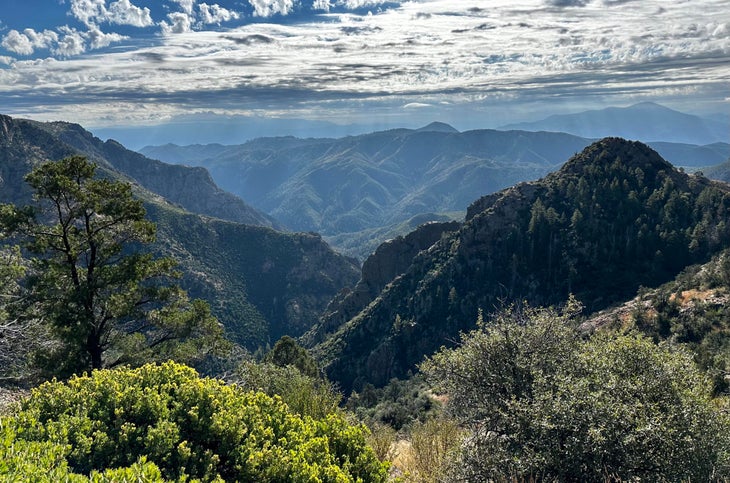
5 Tips for Making the Arizona Trail Your First Thru-Hike
1. When you leave Pine headed south, bound for the Mazatzal and Superstition mountains, wear long, durable pants. An unfathomable amount of barbs and spines and catclaw awaits, and, in my tiny shorts, I now look minced.
2. Wear orange. Most of the trail passes through national forest land, so you will inevitably be shocked to turn some corner and find a camouflaged hunter—in my experience, unfailingly nice and fascinated by hikers—wielding a rifle. Stand out for both of your benefits.
3. You will be drinking out of wildlife tanks, cow ponds, turbid rivers, and maybe even mud puddles. Your water filter will get clogged daily. Carry a syringe for backflushing your filter, or your water situation will get much worse.
4. Though the temperatures will often be mild, the direct sun exposure, even long before you reach the state’s Sonoran depths, will nevertheless bake you. Wear a sun hoody; once again, I cannot recommend Coalatree’s Suray enough.
5. As you head south in the fall, your daylight will steadily disappear. If you want to make miles, you’ll be hiking before dawn or after dusk in cool desert darkness. Get a headlamp you love, and prepare to identify animals by the shine of their tapeta.

